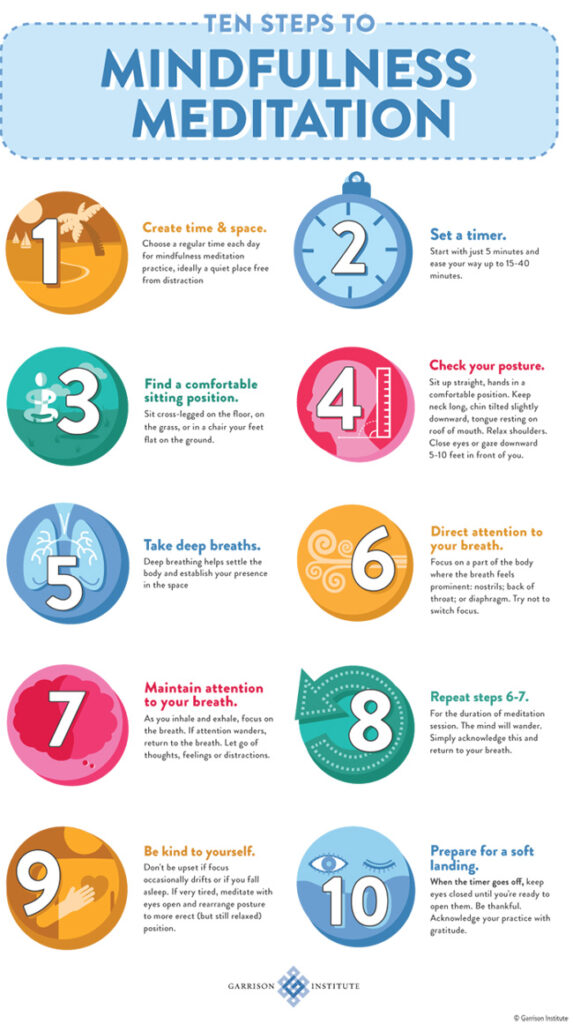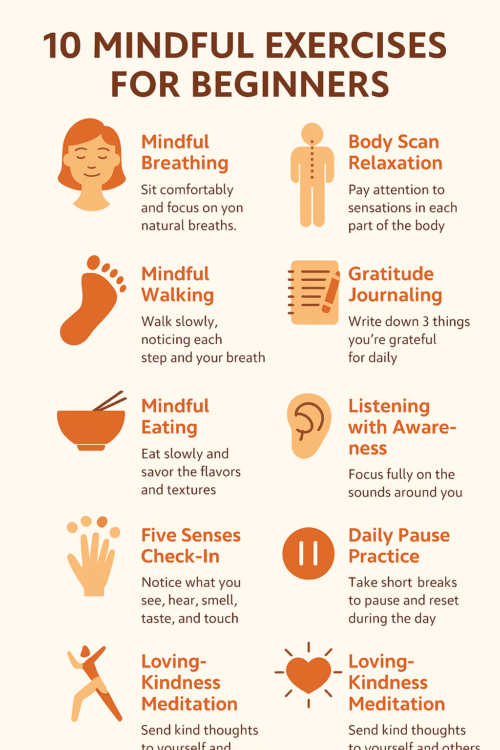Mindful Exercises for Beginners—Introduction

Beginner-friendly mindful exercises are an easy yet effective way to infuse your daily life with balance, calm, and focus. The primary objective of mindfulness is to be curious and kind while paying attention to the present moment, not to clear the mind.
It’s simple to feel anxious, preoccupied, or overburdened in our hectic modern world. Nonetheless, even a short daily mindfulness practice can improve sleep, focus, anxiety levels, and even interpersonal relationships.
The finest aspect? No specialised equipment or extensive training is required. Anywhere—while breathing, walking, eating, or just stopping for a moment—you can practise mindfulness.
Ten mindful exercises for beginners will be covered in this guide, along with advice, advantages, and useful ways to incorporate them into your daily routine.
In this guide, we’ll explore 10 mindful exercises for beginners, along with tips, benefits, and practical ways to fit them into your lifestyle.
Related Read: How Mindfulness and Breath Awareness Enhance Your Yoga Practice
What is Mindfulness?
What exactly is mindful living? The definition of mindfulness involves being fully present and cognizant of your thoughts, feelings, and surroundings without making judgements. Instead of focusing on the past or worrying about the future, mindfulness encourages us to live in the present.
According to Harvard Health Publishing, mindfulness improves mood, reduces stress, and increases focus (source). Beginning learners don’t have to struggle with mindfulness. The first step may be simple, daily practices that train the mind to slow down and focus on the here and now.
10 Mindful Exercises for Beginners
1. Mindful Breathing
One of the simplest mindful exercises for beginners is breathing with awareness.
How to do it:
- Sit comfortably and close your eyes.
- Take slow, deep breaths.
- Notice the rise and fall of your chest.
- If your mind wanders, gently bring it back to your breath.
Tip: Try for 2–5 minutes daily.
2. Body Scan Relaxation
A body scan helps you reconnect with your body and release hidden tension.
How to do it:
- Lie down or sit in a quiet space.
- Close your eyes and take deep breaths.
- Slowly shift your attention from head to toe.
- Notice any tension and let it soften.
This exercise promotes deep relaxation and better sleep.
3. Mindful Walking
Walking can become a moving meditation when done mindfully.
How to do it:
- Walk slowly in a quiet space.
- Pay attention to each step—the lift, move, and touch.
- Sync your steps with your breathing.
- Notice the sights, sounds, and sensations around you.
Even 5 minutes of mindful walking outdoors can reduce stress and improve focus.
Related Read: The benefits of Brisk walking to stay calm and live longer
4. Gratitude Journaling
Mindfulness also means noticing the good things in life. Gratitude journaling trains your mind to focus on positivity.
How to do it:
- Keep a small notebook by your bed.
- Every day, write down 3 things you’re grateful for.
- Be specific—small things count (a smile, a warm meal, a kind word).
This exercise improves mood and resilience.
5. Mindful Eating
Instead of rushing through meals, try eating slowly with full attention.
How to do it:
- Choose one meal or snack to eat mindfully.
- Notice the colors, smells, textures, and flavors.
- Chew slowly, without distractions like TV or phone.
- Pause between bites to savor the food.
Mindful eating helps improve digestion and reduces overeating.
6. Listening with Awareness
Often, we listen to respond instead of truly hearing others. Mindful listening deepens relationships.
How to do it:
- During conversations, focus fully on the speaker.
- Notice tone, expressions, and emotions.
- Resist the urge to interrupt.
- Respond thoughtfully after they finish.
This exercise improves empathy and communication.
7. Five Senses Check-In
This quick mindfulness practice grounds you in the present moment.
How to do it:
- Notice 5 things you see.
- Notice 4 things you can touch.
- Notice 3 things you hear.
- Notice 2 things you smell.
- Notice 1 thing you taste.
It’s perfect for reducing anxiety and centering yourself in stressful moments.
8. Stretching with Attention
Gentle yoga or stretching utilizing an eco-friendly yoga mat and strap for enhanced comfort and support can become a mindful practice when infused with conscious awareness.
How to do it:
- Choose simple stretches (like forward bends or cat-cow).
- Move slowly, focusing on each muscle stretch.
- Breathe deeply and notice sensations.
Related Read: The Benefits of Neuro Yoga | Brain-Body Healing & Mental Clarity
Affiliate Suggestion: Eco-Friendly Yoga Mat + Strap for comfort and support.
9. Daily Pause Practice
Even short pauses throughout the day can refresh the mind.
How to do it:
- Set a reminder to pause every few hours.
- Stop whatever you’re doing.
- Take 3 deep breaths.
- Notice your thoughts, feelings, and surroundings.
Just 1–2 minutes can prevent burnout and boost clarity.
10. Loving-Kindness Meditation
Also called Metta Meditation, this practice cultivates compassion for yourself and others.
How to do it:
- Sit quietly and close your eyes.
- Repeat silently: “May I be happy, may I be healthy, may I live with ease.”
- Extend these wishes to loved ones, strangers, and even people you find difficult.
Studies show loving-kindness meditation Practice increases positive emotions and empathy.
Tips for Beginners
- Start with 5 minutes a day and build gradually.
- Choose 1–2 practices that feel easy for you.
- Be patient—wandering thoughts are natural.
- Consistency is more important than perfection.
Benefits of Mindful Exercises
Practicing mindful exercises for beginners brings both physical and mental benefits:
- Reduces stress and anxiety.
- Improves focus and memory.
- Enhances emotional well-being.
- Supports better sleep.
- Increases self-awareness and empathy.
Related Read: The Best Books to Rebuild Life: 6 Powerful Reads That Can Help You Start Over
Conclusion
Mindfulness doesn’t require special tools or long hours of meditation. With these 10 mindful exercises for beginners, you can bring calm, focus, and positivity into your everyday routine.
Start small—pick one or two exercises and practice them daily. Over time, you’ll notice more clarity, peace, and resilience in your life.
FAQ Section
Q1: How long should beginners practice mindfulness daily?
Start with 5–10 minutes and increase gradually.
Q2: Do I need special tools for mindful exercises?
No, just a quiet space and your attention. Optional tools like a yoga mat or journal can help.
Q3: Can mindfulness help with anxiety?
Yes, mindful exercises reduce stress, calm the nervous system, and improve emotional balance.
Q4: What is the easiest mindful exercise for beginners?
Mindful breathing is the simplest and most effective way to start.

